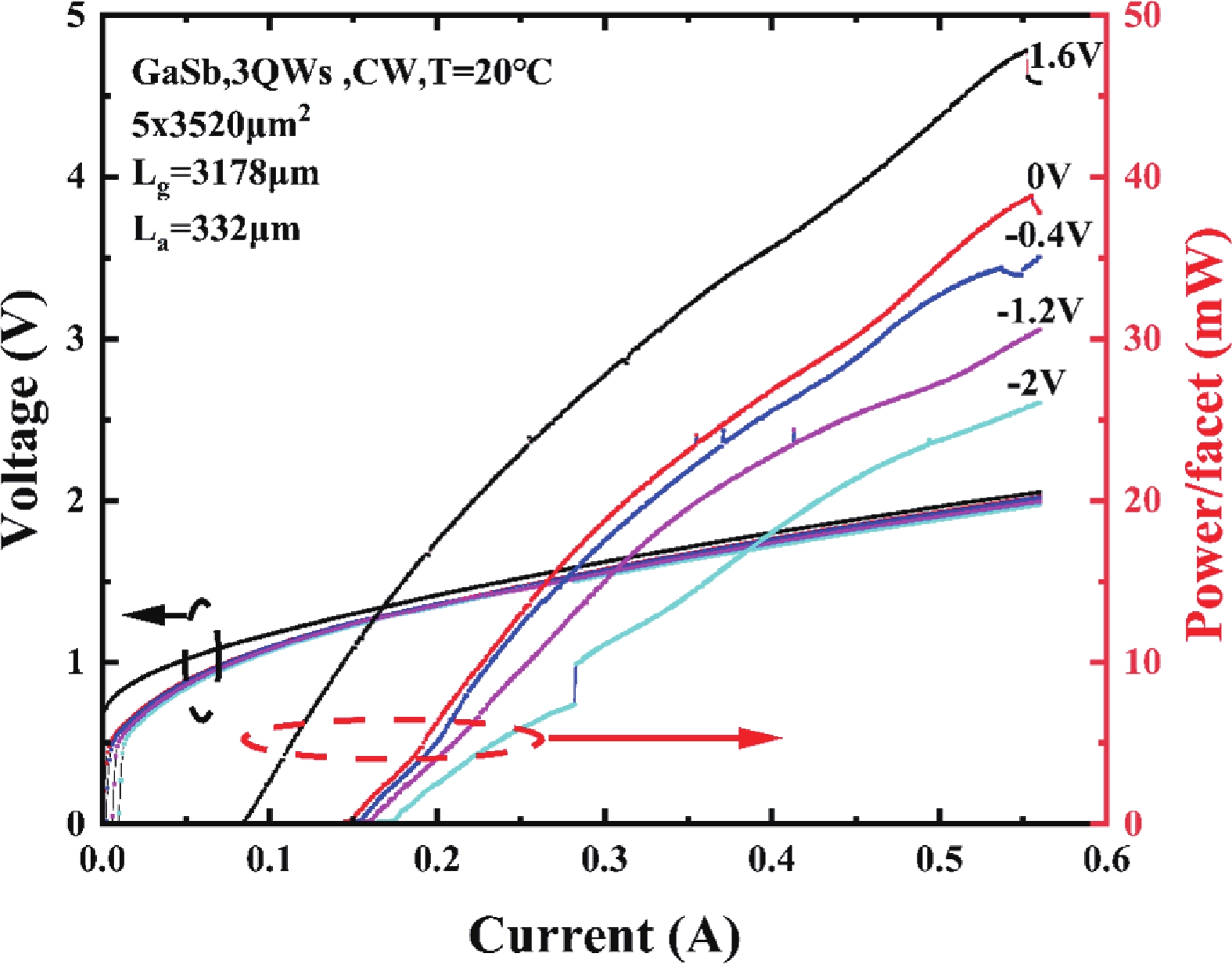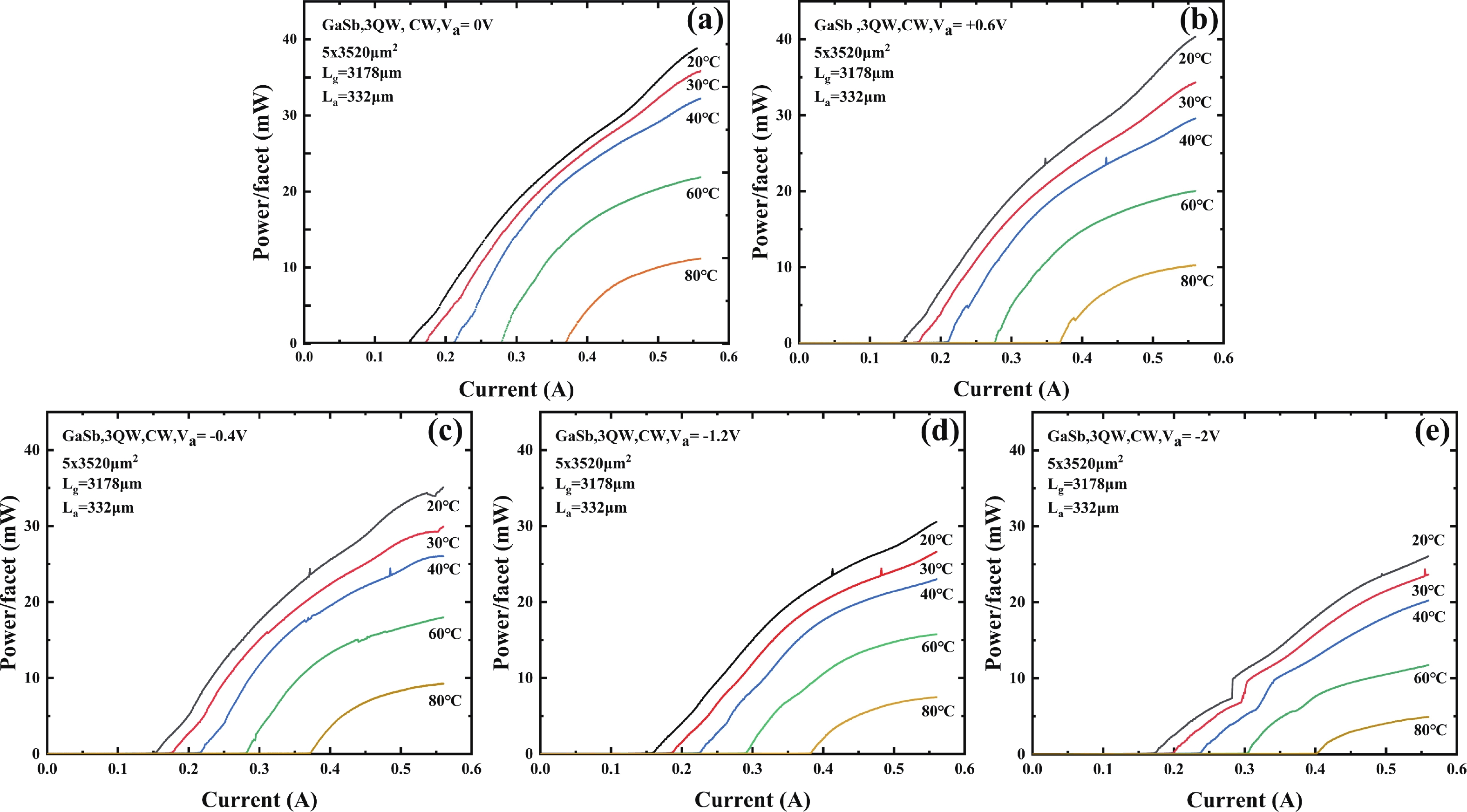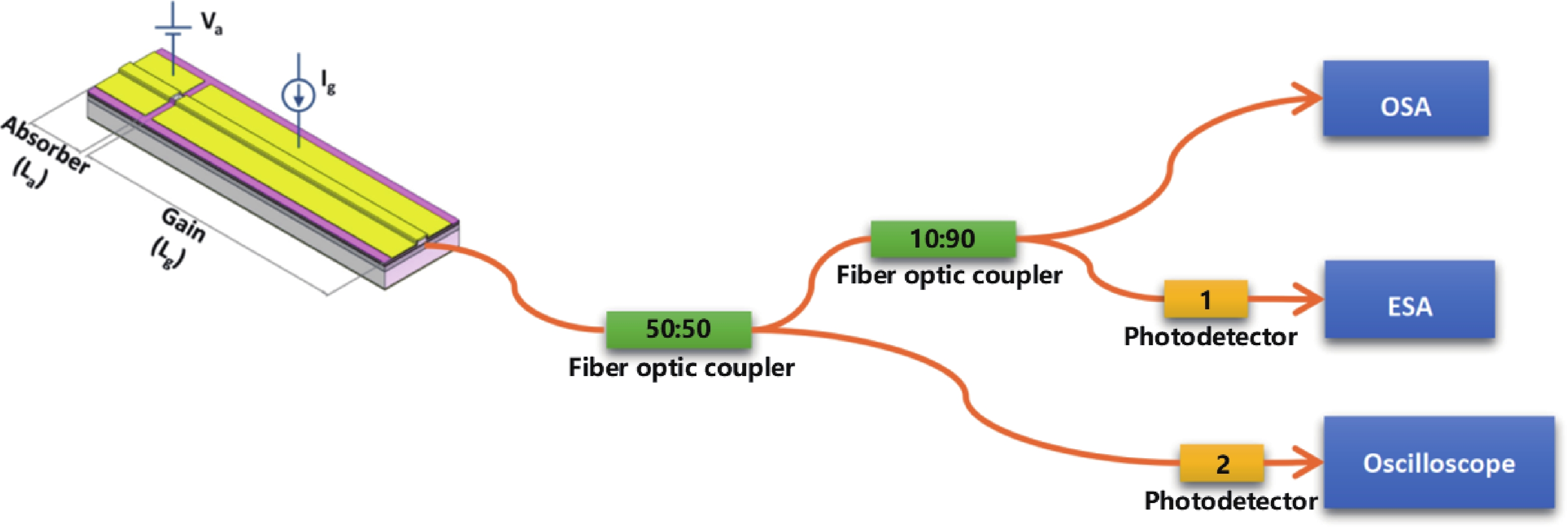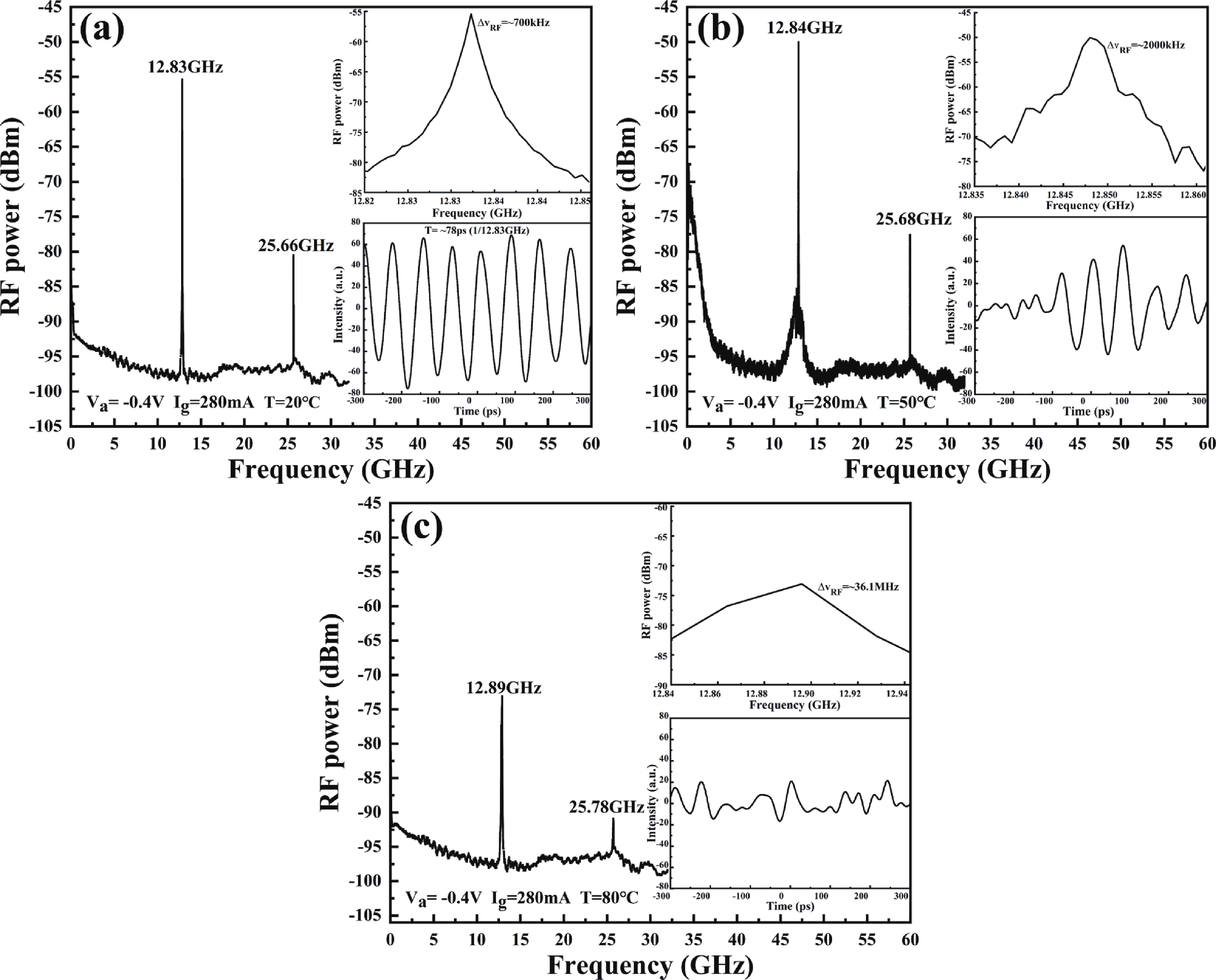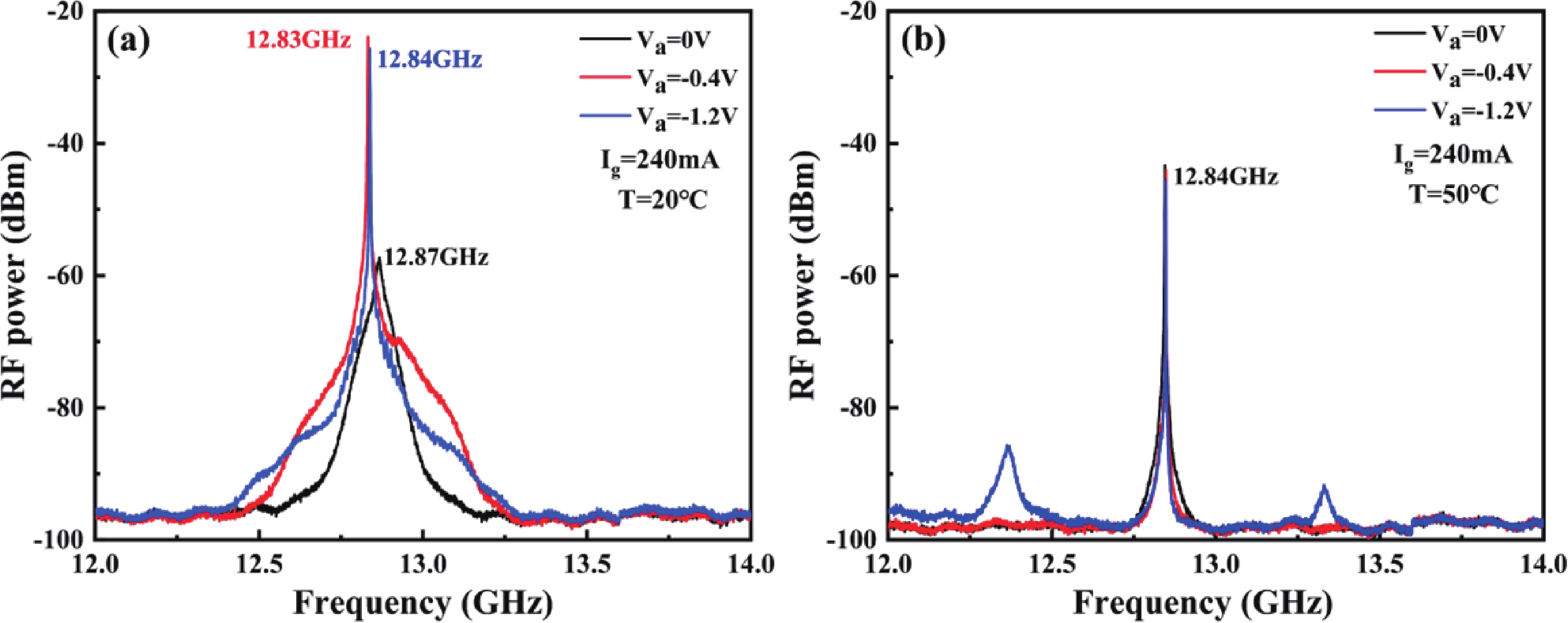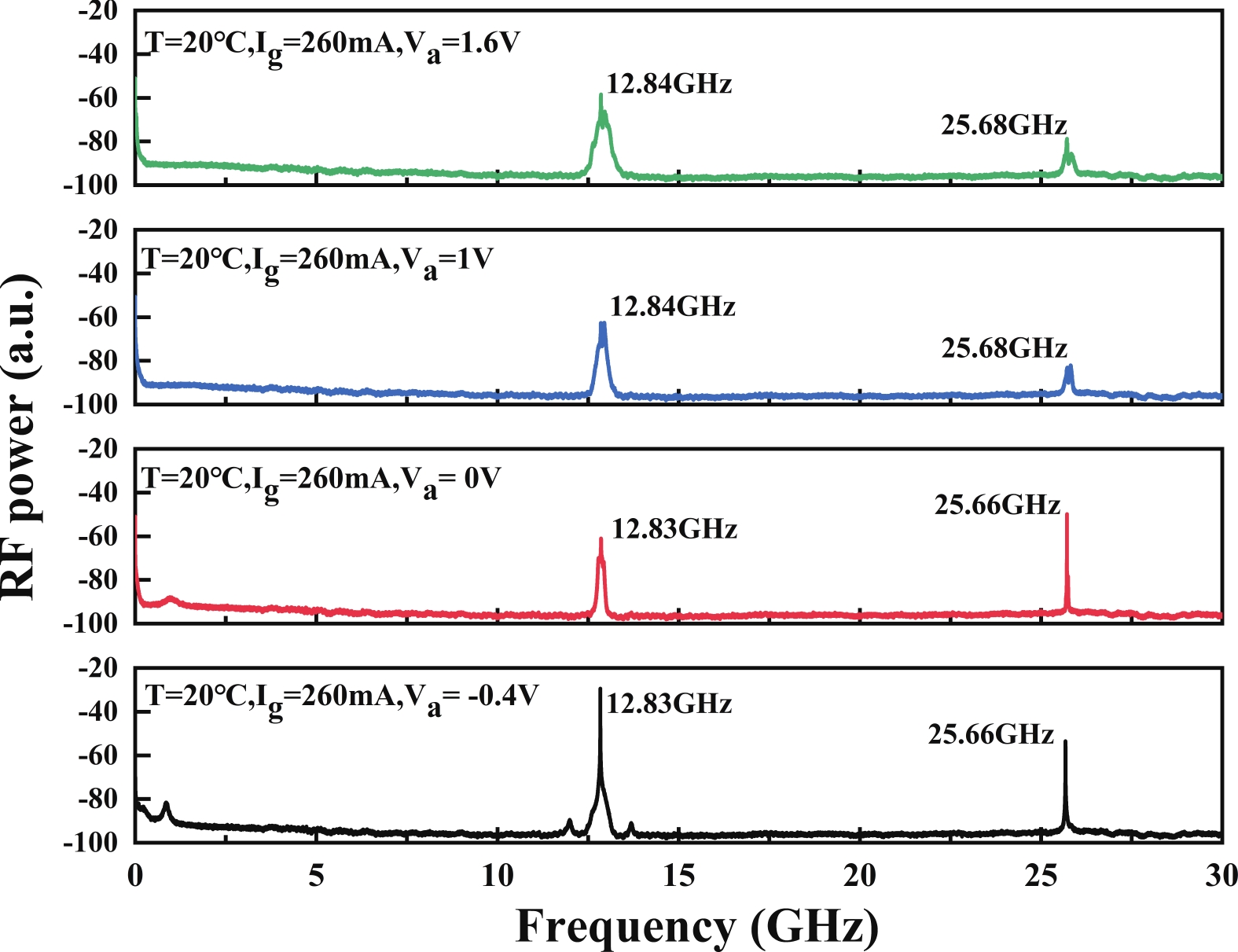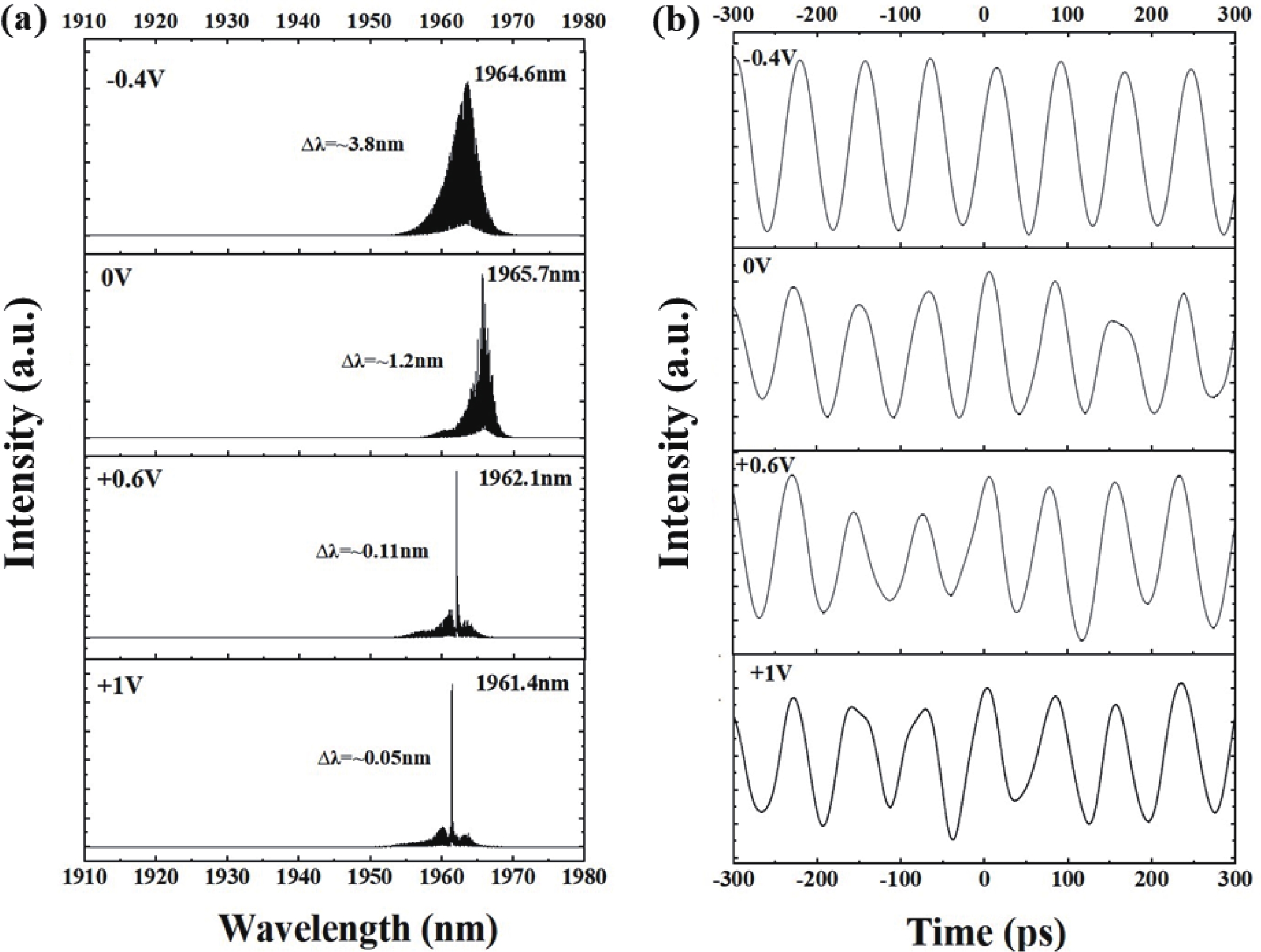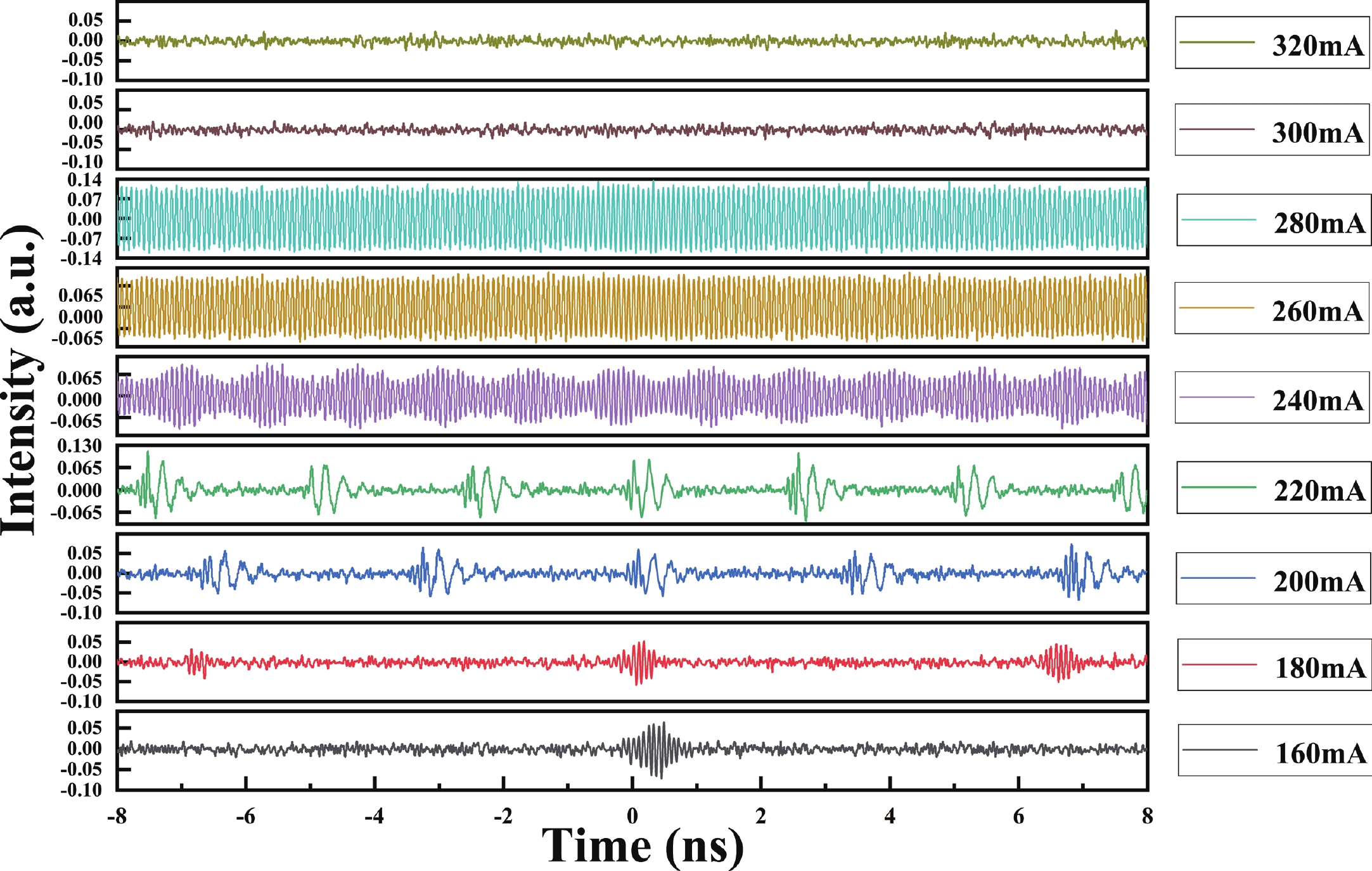| Citation: |
Wenjun Yu, Zhongliang Qiao, Xiang Li, Jia Xu Brian Sia, Dengqun Weng, Xiaohu Hou, Zaijin Li, Lin Li, Hao Chen, Zhibin Zhao, Yi Qu, Chongyang Liu, Hong Wang, Yu Zhang, Zhichuan Niu. Research on optical soliton characteristics GaSb-based ~2 μm wavelength two-section integrated optical chip[J]. Journal of Semiconductors, 2025, 46(11): 112403. doi: 10.1088/1674-4926/25030011
****
W J Yu, Z L Qiao, X Li, J X B Sia, D Q Weng, X H Hou, Z J Li, L Li, H Chen, Z B Zhao, Y Qu, C Y Liu, H Wang, Y Zhang, and Z C Niu, Research on optical soliton characteristics GaSb-based ~2 μm wavelength two-section integrated optical chip[J]. J. Semicond., 2025, 46(11), 112403 doi: 10.1088/1674-4926/25030011
|
Research on optical soliton characteristics GaSb-based ~2 μm wavelength two-section integrated optical chip
DOI: 10.1088/1674-4926/25030011
CSTR: 32376.14.1674-4926.25030011
More Information-
Abstract
The optical soliton characteristics of GaSb-based ~2 μm wavelength integrated optical chips have broad application prospects in optoelectronic fields such as optical communications, infrared countermeasures, and gas environment monitoring. In the research of two-section integrated optical chips, more attention is paid to their passive mode-locked characteristics. The ability of its structure to generate stable soliton transmission has not yet been studied, which will limit its further application in high-performance near-mid infrared optoelectronic technology. In this paper, we design and prepare a GaSb-based ~2 μm wavelength two-section integrated semiconductor laser chip structure, and test and analyze its related properties of soliton, including power−injection current−voltage (P−I−V), temperature and mode-locked characteristics. Experimental results show that the chip can achieve stable mode-locked operation at nearly ~2 μm wavelength and present the working characteristics of near optical soliton states and multi-peak optical soliton states. By comparing and analyzing the measured optical pulse sequence curve with the numerical fitting based on the pure fourth order soliton approximation solution, it is confirmed that the two-section integrated optical chip structure can generate stable transmission of multi-peak optical soliton. This provides a research direction for developing near-mid infrared mode-locked integrated optical chips with high-performance property of optical soliton.-
Keywords:
- integrated optical chip,
- GaSb-based,
- mode-locked,
- optical soliton
-
References
[1] Keller U, Tropper A C. Passively modelocked surface-emitting semiconductor lasers. Phys Rep, 2006, 429(2), 67 doi: 10.1016/j.physrep.2006.03.004[2] Gaafar M A, Rahimi-Iman A, Fedorova K A, et al. Mode-locked semiconductor disk lasers. Adv Opt Photon, 2016, 8(3), 370 doi: 10.1364/AOP.8.000370[3] Zou Y, Chakravarty S, Chung C J, et al. Mid-infrared silicon photonic waveguides and devices. Photon Res, 2018, 6(4), 254 doi: 10.1364/PRJ.6.000254[4] Boehm G, Bachmann A, Rosskopf J, et al. Comparison of InP- and GaSb-based VCSELs emitting at 2.3 μm suitable for carbon monoxide detection. J Cryst Growth, 2011, 323(1), 442 doi: 10.1016/j.jcrysgro.2010.11.174[5] Härkönen A, Guina M, Okhotnikov O, et al. 1-W antimonide-based vertical external cavity surface emitting laser operating at 2-microm. Opt Express, 2006, 14(14), 6479 doi: 10.1364/OE.14.006479[6] Li X, Sia J X B, Wang W J, et al. Phase noise reduction of a 2 µm passively mode-locked laser through hybrid III-V/silicon integration. Optica, 2021, 8(6), 855 doi: 10.1364/OPTICA.416007[7] Geng J H, Jiang S B. Fiber lasers: The 2 μm market heats up. Optics & Photonics News, OPN, 2014, 25(7), 34 doi: 10.1364/OPN.25.7.000034[8] Taczak T M, Killinger D K. Development of a tunable, narrow-linewidth, cw 2066-μm Ho: YLF laser for remote sensing of atmospheric CO2 and H2O. Appl Opt, 1998, 37(36), 8460 doi: 10.1364/AO.37.008460[9] Bekman H H P T, van den Heuvel J C, van Putten F J M, et al. Development of a mid-infrared laser for study of infrared countermeasures techniques. Technologies for Optical Countermeasures, 2004, 5615[10] Petrovich M N, Poletti F, Wooler J P, et al. Demonstration of amplified data transmission at 2 µm in a low-loss wide bandwidth hollow core photonic bandgap fiber. Opt Express, 2013, 21(23), 28559 doi: 10.1364/OE.21.028559[11] Dvinelis E, Trinkūnas A, Greibus M, et al. High-performance GaSb laser diodes and diode arrays in the 2.1-3.3 micron wavelength range for sensing and defense applications. Quantum Sensing and Nanophotonic Devices XII, 2015, 9370 doi: 10.1117/12.578214[12] Meng W. GaSb-based type-I quantum well tunable diode lasers for spectral range above 3 µm. PhD Dissertation, University of Stony Brook, 2018 (in America[13] Vizbaras A, Dvinelis E, Trinkunas A, et al. High-performance mid-infrared GaSb laser diodes for defence and sensing applications. Laser Technology for Defense and Security X, 2014, 104 doi: 10.1117/12.2054493[14] Cáceres-Pablo I, Ania-Castañón J D. Real-time transition dynamics of harmonically mode-locked femtosecond ultralong ring fiber lasers. J Light Technol, 2024, 42(13), 4643 doi: 10.1109/JLT.2024.3369978[15] Herr T, Brasch V, Jost J D, et al. Temporal solitons in optical microresonators. Nat Photonics, 2014, 8, 145 doi: 10.1038/nphoton.2013.343[16] Wang J D, Lu Z Z, Wang W Q, et al. Long-distance ranging with high precision using a soliton microcomb. Photonics Res, 2020, 8(12), 1964 doi: 10.1364/PRJ.408923[17] Li X, Wang H, Qiao Z L, et al. Design and analysis of 2-μm InGaSb/GaSb quantum well lasers integrated onto silicon-on-insulator (SOI) waveguide circuits through an Al2O3 bonding layer. IEEE J Sel Top Quantum Electron, 2016, 22(6), 1500507 doi: 10.1109/JSTQE.2016.2553448[18] Li X, Wang H, Qiao Z L, et al. Temperature-dependent phase noise properties of a two-section GaSb-based mode-locked laser emitting at 2 μm. Appl Phys Lett, 2020, 117(14), 141103 doi: 10.1063/5.0024064[19] Li X, Wang H, Qiao Z L, et al. High temperature characteristics of a 2 μm InGaSb/AlGaAsSb passively mode-locked quantum well laser. Appl Phys Lett, 2019, 114(22), 221104 doi: 10.1063/1.5096447[20] Joullié A, Christol P. GaSb-based mid-infrared 2–5 μm laser diodes. Comptes Rendus Phys, 2003, 4(6), 621 doi: 10.1016/S1631-0705(03)00098-7[21] Gao F, Qin L, Chen Y Y, et al. Two-segment gain-coupled distributed feedback laser. IEEE Photonics J, 2018, 10(1), 1500509 doi: 10.1109/JPHOT.2018.2791610[22] Qiao Z L, Li X, Sia J X, et al. Stable mode-locked operation with high temperature characteristics of a two-section InGaAs/GaAs double quantum wells laser. IEEE Access, 2021, 9, 16608 doi: 10.1109/ACCESS.2021.3051179[23] Qiao Z L, Li X, Jia X B S, et al. Mode-locked operation characteristics of a monolithic integrated two-section InGaAs/GaAs double quantum wells laser with asymmetric waveguide. Opt Laser Technol, 2022, 147, 107702 doi: 10.1016/j.optlastec.2021.107702[24] Jiang L W, Ye X L, Zhou X L, et al. Optical bistability in a two-section InAs quantum-dot laser. J Semicond, 2010, 31(11), 55[25] Huang X D, Stintz A, Li H, et al. Passive mode-locking in 1.3 μm two-section InAs quantum dot lasers. Appl Phys Lett, 2001, 78(19), 2825 doi: 10.1063/1.1371244[26] Tao F. High power, narrow spectrum and passively mode-locked GaSb-based type-I quantum well cascade diode lasers. PhD Dissertation, University of Stony Brook, 2018 (in America[27] Zyoud S H, Abdelkader A, Zyoud A H. The impact of temperature on the performance of semiconductor laser diode. Int J Adv Sci Technol, 2020, 29, 1167[28] Rong J M, Xing E B, Zhang Y, et al. Low lateral divergence 2 μm InGaSb/AlGaAsSb broad-area quantum well lasers. Opt Express, 2016, 24(7), 7246 doi: 10.1364/OE.24.007246[29] Malins D B, Gomez-Iglesias A, White S J, et al. Ultrafast electroabsorption dynamics in an InAs quantum dot saturable absorber at 1.3 μm. Appl Phys Lett, 2006, 89(17), 171111 doi: 10.1063/1.2369818[30] Li X, Wang H, Qiao Z L, et al. Modal gain characteristics of a 2 μm InGaSb/AlGaAsSb passively mode-locked quantum well laser. Appl Phys Lett, 2017, 111(25), 251105 doi: 10.1063/1.5010015[31] Qiao Z L, Li X, Sia J X B, et al. Modal gain characteristics of a two-section InGaAs/GaAs double quantum well passively mode-locked laser with asymmetric waveguide. Sci Rep, 2022, 12, 5010 doi: 10.1038/s41598-022-09136-6[32] Diddams S A, Vahala K, Udem T. Optical frequency combs: Coherently uniting the electromagnetic spectrum. Science, 2020, 369(6501), eaay3676 doi: 10.1126/science.aay3676[33] Chang L, Liu S T, Bowers J E. Integrated optical frequency comb technologies. Nat. Photonics, 2022, 16, 95 doi: 10.1038/s41566-021-00945-1[34] Liao Y P, Zhang Y, Xing J L, et al. High power laser diodes of 2 μm AlGaAsSb/InGaSb type I quantum-wells. J Semicond, 2015, 36(5), 54 doi: 10.1088/1674-4926/36/5/054007[35] Djie H S, Tan C L, Ooi B S, et al. Ultrabroad stimulated emission from quantum-dash laser. Appl Phys Lett, 2007, 91(11), 111116 doi: 10.1063/1.2784969[36] Cataluna M A, Viktorov E A, Mandel P, et al. Temperature dependence of pulse duration in a mode-locked quantum-dot laser. Appl Phys Lett, 2007, 90(10), 101102 doi: 10.1063/1.2711291[37] Aporta Litago I, Leandro D, Quintela M Á, et al. Tunable SESAM-based mode-locked soliton fiber laser in linear cavity by axial-strain applied to an FBG. J Light Technol, 2017, 35(23), 5003 doi: 10.1109/JLT.2017.2769221[38] Gravesen K B, Gardner A B, Ulsig E Z, et al. Nonlinear Schrödinger equation for integrated photonics. J Opt Soc Am B, 2024, 41(6), 1451 doi: 10.1364/JOSAB.517190[39] Blanco-Redondo A, de Sterke C M, Sipe J E, et al. Pure-quartic solitons. Nat Commun, 2016, 7(1), 10427 doi: 10.1038/ncomms10427[40] Gao P, Liu C, Zhao L C, et al. Modified linear stability analysis for quantitative dynamics of a perturbed plane wave. Phys Rev E, 2020, 102(2), 022207 doi: 10.1103/PhysRevE.102.022207[41] Zhao L C, Ling L M. Quantitative relations between modulational instability and several well-known nonlinear excitations. J Opt Soc Am B, 2016, 33(5), 850 doi: 10.1364/JOSAB.33.000850[42] Vithya A, Mani Rajan M S. Impact of fifth order dispersion on soliton solution for higher order NLS equation with variable coefficients. J Ocean Eng Sci, 2020, 5(3), 205 doi: 10.1016/j.joes.2019.11.002[43] Alaydin B Ö, Gaulke M, Heidrich J, et al. Bandgap engineering, monolithic growth, and operation parameters of GaSb-based SESAMs in the 2–2.4 µm range. Opt Mater Express, 2022, 12(6), 2382 doi: 10.1364/OME.459232 -
Proportional views





 Wenjun Yu was born in Guangdong Province, China. Since September 2022, he has been studying for a master's degree and master's program in Hainan Normal University. He is mainly engaged in the research of GaSb and InP-based chip integration, optical frequency comb, semiconductor laser and optical communication.
Wenjun Yu was born in Guangdong Province, China. Since September 2022, he has been studying for a master's degree and master's program in Hainan Normal University. He is mainly engaged in the research of GaSb and InP-based chip integration, optical frequency comb, semiconductor laser and optical communication. Zhongliang Qiao received the Ph.D. degree in engineering optics from the National Key Laboratory on High Power Semiconductor Lasers, Changchun University of Science and Technology (CUST), Jilin, China, in 2011. He was a Postdoctoral Researcher with the Singapore Project from 2011 to 2013 and a Research Fellow with the School of Electrical and Electronic Engineering, NTU, Singapore, from 2015 to 2019. He has been a Professor with the Key Laboratory of Laser Technology and Optoelectronic Functional Materials of Hainan Province, School of Physics and Electronic Engineering, Hainan Normal University, Haikou, Hainan, China, from 2019 to 2025. He has been a Researcher with the China Electronics Technology Group 11 Institute, Beijing, China, from 2025 to now. He is currently developing InP-based QCL and GaSb-based ~2.0 μm semiconductor laser chips as well as optical frequency comb monolithic integration research. He has also conducted research on the preparation and application of tunable semiconductor laser-related devices. He has authored and coauthored more than 130 technical articles in these fields so far.
Zhongliang Qiao received the Ph.D. degree in engineering optics from the National Key Laboratory on High Power Semiconductor Lasers, Changchun University of Science and Technology (CUST), Jilin, China, in 2011. He was a Postdoctoral Researcher with the Singapore Project from 2011 to 2013 and a Research Fellow with the School of Electrical and Electronic Engineering, NTU, Singapore, from 2015 to 2019. He has been a Professor with the Key Laboratory of Laser Technology and Optoelectronic Functional Materials of Hainan Province, School of Physics and Electronic Engineering, Hainan Normal University, Haikou, Hainan, China, from 2019 to 2025. He has been a Researcher with the China Electronics Technology Group 11 Institute, Beijing, China, from 2025 to now. He is currently developing InP-based QCL and GaSb-based ~2.0 μm semiconductor laser chips as well as optical frequency comb monolithic integration research. He has also conducted research on the preparation and application of tunable semiconductor laser-related devices. He has authored and coauthored more than 130 technical articles in these fields so far.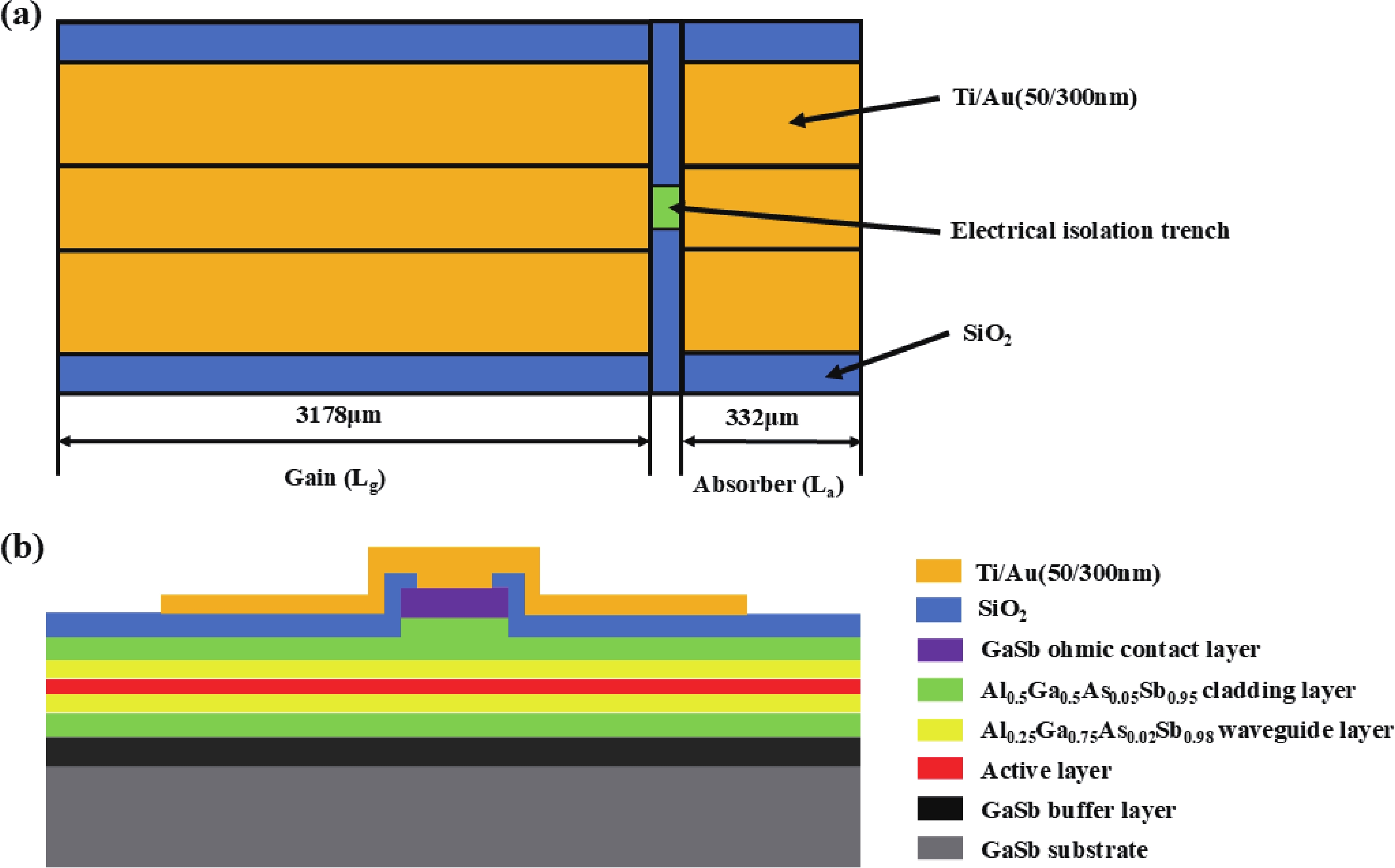
 DownLoad:
DownLoad:
